COVID19: How are Shopping Malls all over the world dealing with the Covid-19 pandemic?
24 min read
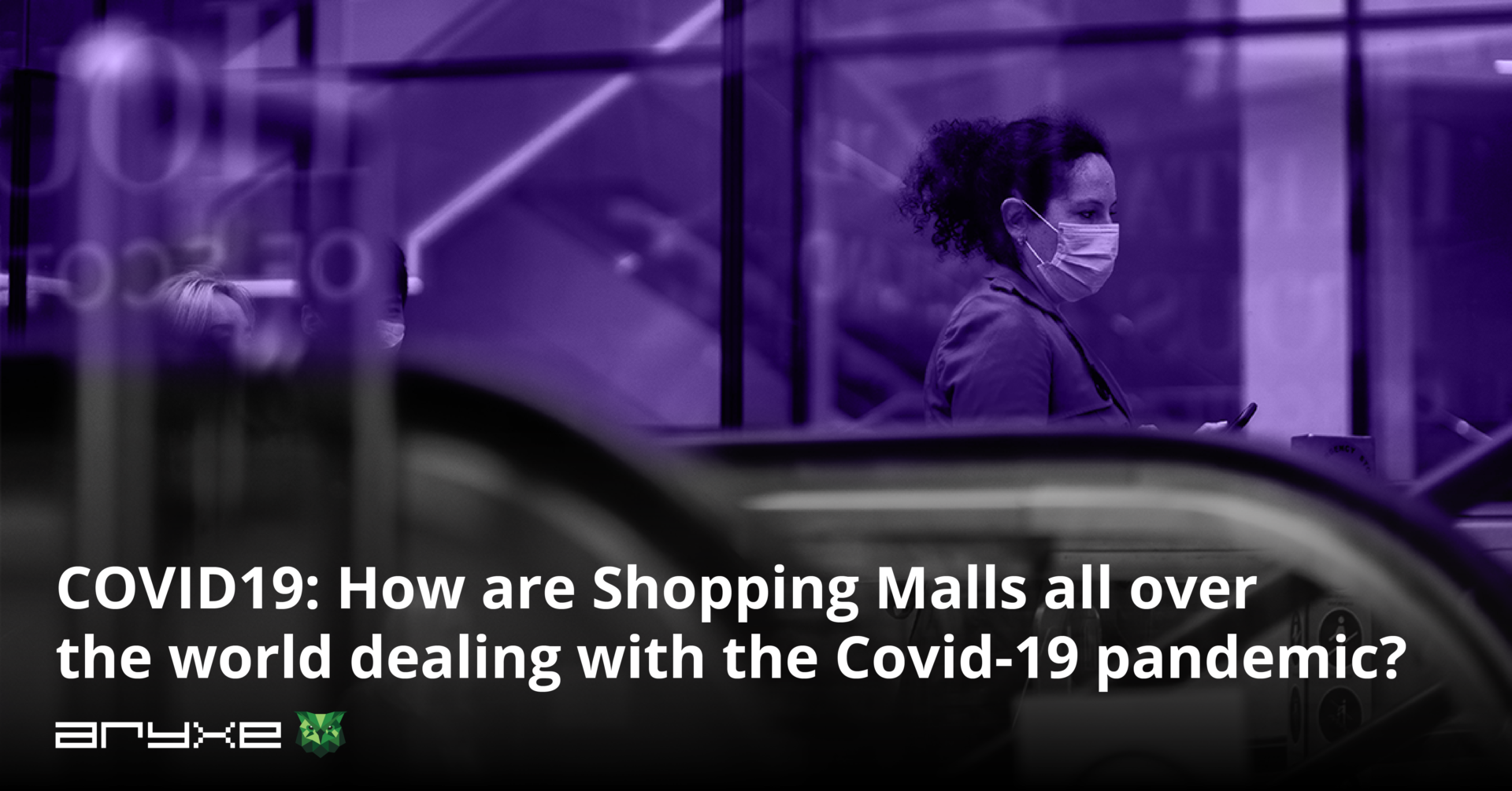
24 min read

by Aleksandra Gagic
We have got a few Covid-19 articles under our belt already but we are far from where we would like to be. We are aiming at covering as many industries and sectors as we possibly can in order to do thorough research and supply our readers with some valuable information about the Covid-19 pandemic, its impact on the specific industries, and possible mitigation strategies. Knowing that we have already covered Aviation, Hotels, Restaurants, and the Cruise Industry, we have decided to cover Shopping Malls and the way the world of exchanging goods has been impacted by the Covid-19 pandemic. In order to continue the series in our usual manner, we will start by covering the history of shopping, the creation of shopping malls, and the way they are now dealing with the Covid-19 pandemic. We will make sure to discuss the statistics, touch on some of the most famous brands and the ways they are impacted by the pandemic. Finally, we will share advice on how businesses can do their best to keep their regular customers, acquire new ones, keep their employees and customers safe, and survive this crisis.
People have been sharing, exchanging, selling, and consuming goods for nearly as long as they have existed. In order to trace the complete history of commerce back to the very birth of it, we should probably start talking of a time where wooly mammoths were still walking this beautiful Earth of ours. People found that exchanging cows and sheep can help them survive – and all of this was happening way back, thousands of years BC. The very first currency showed up around 3000 BC in Mesopotamia. When it comes to the birth of retail stores, we should think about the 800s BC, when Greek have developed their markets with many merchants selling their goods in the city center.
The agora, which essentially stands for a marketplace, was a public space and an extremely important part of ancient Greek polis or city-state. Agora can also stand for a place of assembly in any Ancient Greek state. It is sometimes used in modern language to refer to a crossroads, either metaphorically (the point or concept which links, or the crossroads of multiple related concepts), or literally (a point at which many physical roads or paths meet).
Fast forward a few thousand years, and the modern mammoths are right in front of us, all the Walmarts, Targets, Costocos, Macy’s, and many more. But what was going on in between these years? As we all know, development can almost seem like a seamless experience, but we’re here to tell you exactly how the evolution of retail and retail shopping happened. You’re probably already aware of some of the most important markers, such as the post-Industrial Revolution when the era of retail really took off, and the Digital Revolution – the biggest game-changer, also known as e-commerce.
The sale of different services or goods, with the intention to make a profit, is called retail.
Now that we have reiterated what’s probably common knowledge, it’s high time we learned more about the development of retail and how it got to where it is now.
Initially, there were mom and pop’s stores, which was a colloquial way of describing independent, family-owned, and (naturally) small businesses. These stores were to be found mostly in the 18th and 19th century and many of them were drug stores or just selling anything and everything starting from groceries to fabrics, toys, and tools.
In the 19th and 20th centuries, the business and economic sectors endured severe changes. Agriculture, as a previously rather dominant business, was replaced by manufacturing and other industries. Steel, textile, food, and oil factory production brought new jobs and impacted life standards.
Naturally, with more affluent and successful people having broader tastes, department stores started popping up in large cities. So, in the US Macy’s was founded in 1858, Bloomingdales in 1861, and Sears in 1886. In Europe, one of the largest multinational retailers was and still is, UK’s Marks and Spencer, founded in 1884, which currently has over 1400 locations.
These grand places inevitably started influencing what people were buying, how they were furnishing their homes, and what they thought they needed. In fact, these weren’t places where simple items were being sold. They provided lectures, entertainment, and demonstrations, ensuring they appeal to the new, wealthy consumers, looking for a way to use their income. Even today people keep looking for content and experience to be part of their shopping activities, which help influence what they are buying.
We got a tad carried away so let’s circle back to the year 1883. James Ritty, a saloon keeper in Ohio, invented the very first cash register that used metal taps and simple mechanics to keep track of sales. Before this invention, many businesses were struggling to keep track of their accounting and they often weren’t sure whether they were operating at a profit or a loss.
Now, maybe it was hard for you to imagine a store without a register so what do you say about a time when paying cash was exemplary. In the 1920s, so-called charge cards were starting to rule in the shopper’s world. These early cards were usually being issued by hotels and could be used solely within their companies. The very first universal credit card that shoppers could use at multiple establishments was the Diners Club card that surfaced in the 50s.
Obviously, the concept of the agora, where customers can visit multiple merchants has morphed into something else. Today, we have a modern concept of malls, physically built shops that are all connected into one location, with communal facilities. This concept began in the 20th century and the first signs of what we have today started emerging in the 20s. People tend to think that the growth of shopping malls was to be associated with the growth of demand for automobiles. With vehicles being available to the masses, people were leaving cities and easily commuting to the suburbs. Malls are designed as places where people can socialize and come together not only because of shopping but in order to make an experience out of it. By 1960, there were over four thousand malls, accounting for more than 14% of retail sales.
With the new thing, called the internet, retail found yet another channel to boom. One of the important years was 1995 when Amazon was established as an online bookseller. Just last year, Amazon’s income surpassed $11 billion. E-commerce appeared and many people found it much more convenient and efficient than going to a physical location. Shopping online allows you to do it all, whenever and however you want.
This leads us to the era of Facebook, Twitter, and Instagram. Brands are working hard to build their online presence. Facebook is a go-to platform and has millions of active business pages on it. Twitter allows the customers to directly reach out to businesses and Instagram gives them enough space to showcase their products.
With the growth of shopping online, the appeal of shopping malls has started to decline. In 2019, malls got hit by a 20-year low in sales. Certain statistics show that there is also a generational divide in the way people like to shop today. 72% of Baby Boomers like to shop in-store, while as much as 67% of Millennials like to do their shopping online.
The bad news is, the coronavirus pandemic that completely took over the year 2020, won’t help retail, instead, it may completely shift the way we shop in the future. But let’s not get ahead of ourselves – let’s go from the very start of 2020, talk down the numbers and see what’s in store for shopping malls and all the shoppers around the world.
Knowing that the world of retail and shopping malls has been struggling, it shouldn’t come off as a surprise to know that some are arguing malls and retail stores won’t cut it into the new, post-pandemic world.
The coronavirus is something that neither modern retail nor humans have expected from the year 2020. Physical distancing and lockdowns are making a huge impact on consumer behavior, and consequently, the world economy. Meanwhile, the online world took up the baton, and the digitalized shopping experience has been further enhanced. Still, online shopping shouldn’t be seen as the best solution that shall erase everything we were building since the agorae. Additionally, the increased demand for online shopping has unintentionally shed light on its shortcomings. As stores faced shutdowns and closures all over the world, digital sales took off and reached unprecedented levels, at a high operational cost. Even a huge business such as Amazon, which still grapples with soaring demand, saw significant cost erase profits while trying to keep the customers happy and deliver in its usual, timely fashion.
The customers are also coming to terms with the drawbacks of online shopping. Returning an item can be a truly painful experience. In addition to the customer’s pain, there’s more that comes into play such as excessive packaging, deliveries, additional traffic clogs, and finally additional emission spikes.
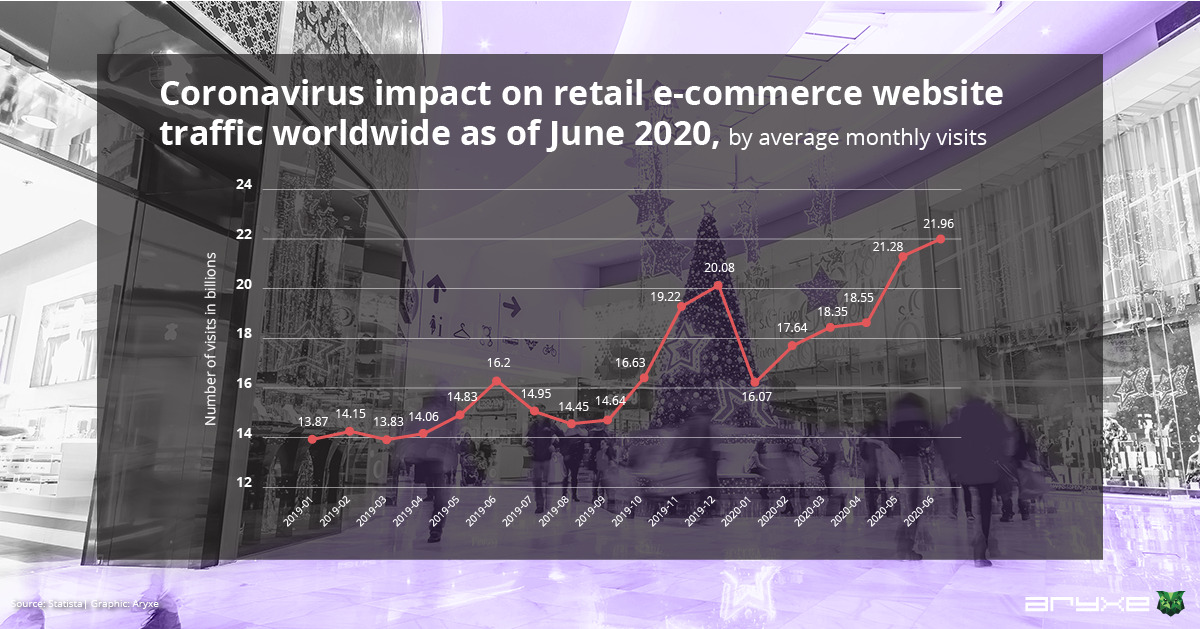
Looking at Statista’s research, it is obvious that retail platforms have undergone unprecedented levels of traffic and demand, which surpassed holiday season peaks, too. All in all, retail platforms generated close to 22 billion visits in June 2020, due to the pandemic that has driven lockdowns and forced people to follow shelter in place orders. Naturally, this made the consumers turn to the internet in order to procure everything starting from everyday items such as groceries all the way to couture.
We’re now in the last quarter of this year and the shift in consumer behavior can’t be denied. Even people whose shopping was heavily online have changed what they are buying. Some have even decided to turn their grocery shopping experience into a completely digital thing.
I have personally turned to online shopping and I am buying stuff that I would normally go to a shopping mall for, online. This hasn’t been a very smooth experience every time, and that’s to be expected. No retail had a “pandemic plan” so they are doing what they can to keep the business going, and we should have some sort of understanding of it.
So, Covid-19 has undoubtedly turbocharged the growth of online shopping. This is resulting in physical shop closures and vacant spaces.
To paint a picture clearly, let’s take a look at what Australia is dealing with when it comes to the number of online purchases:
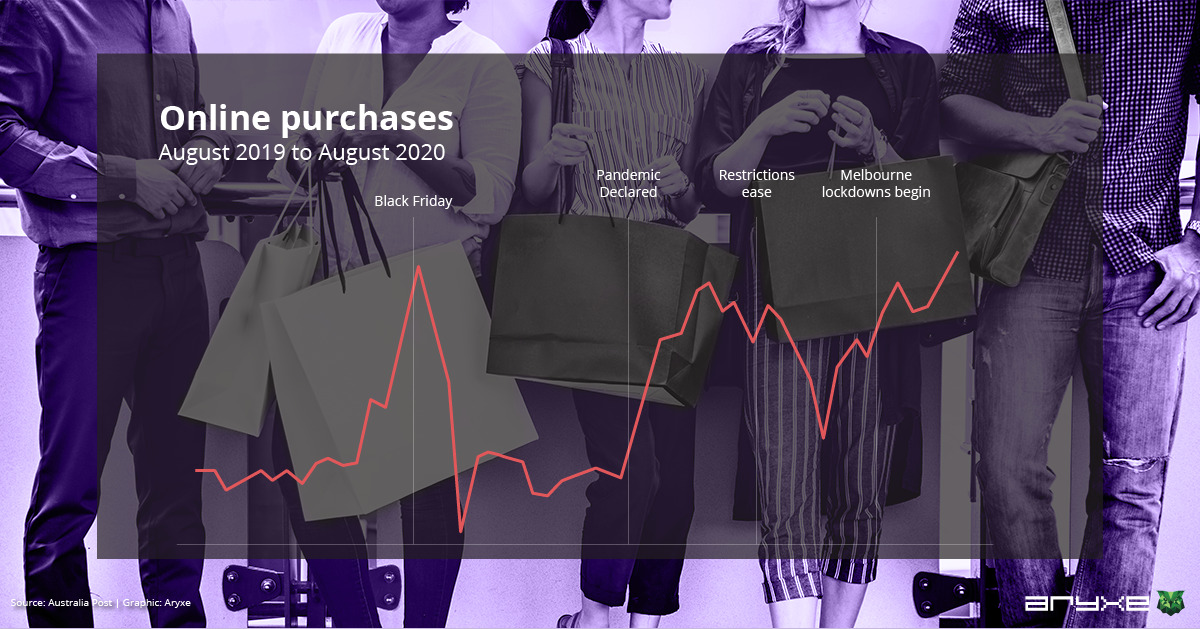
This picture shows that a predicted five-year rise of e-commerce turned to just a few months. Data is showing that there has been over 60% increase in online retail sales in the 12 months to July.
Foot traffic is now turning to web traffic. So, let’s go over some facts:
Not many people in retail could have known that a newly discovered virus would end up spreading widely beyond the borders of China earlier this year, morph into a global pandemic and lead to a recession that would naturally change the trajectory of many businesses.
Many even thought of it as a relatively short disruption that will not in any way impact long-term initiatives and strategies. In March, the spread of Covid-19 brought the majority of this world of ours to a halt. People stayed at homes for weeks during shelter-in-place orders. As a logical turn of events, clothing stores and shopping malls with apparel stores were temporarily closed.
Fast forward to the current times, as a global number of infections went up to over 90 million, retailers are facing a new reality. Some of them have already filed for bankruptcy, laid off thousands of their employees, and are in process of liquidating stores. Still, there are some that have actually benefited as their consumers adapt to their new daily routines, working from home, learning from home, and sheltering in place.
How many of you have enjoyed having a hands-on experience at the mall before the pandemic? Ever tried eating samples at the grocery store, spent an afternoon trying on a wardrobe in the fitting room, or just relaxing in the restaurant at the mall? These could be things of the past. Retailers are scrambling around to find ways to limit interactions with employees and/or customers and avoid shared surfaces. They are investing in contactless checkout approaches but also learning the importance of doing business online.
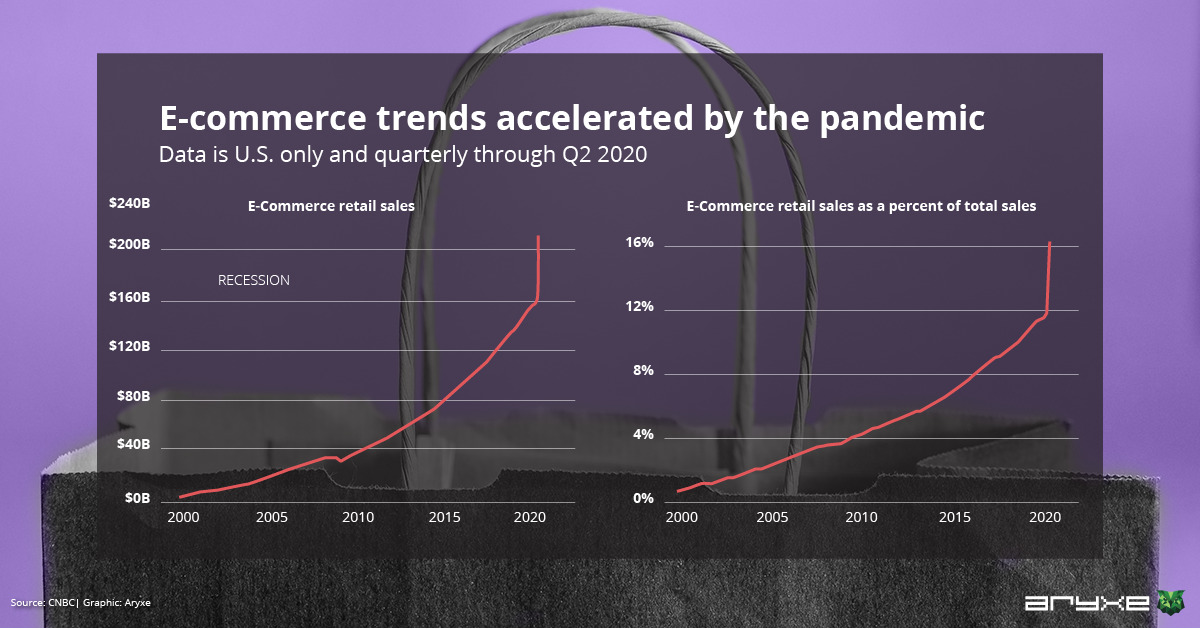
Some retailers are turning their stores into fulfillment centers and mini-warehouses. Gap did exactly that especially when malls were closed for shopping.
In the United States, over the course of this year, close to 36% of online non-food shopping was and will be supported by physical stores, according to GlobalData. They also state that around 68% of American shoppers said they will collect more of their online purchases from inside stores.
This shift has also been altering how retailers use their employees. For instance, Target and Walmart both said they anticipate an increase in the need for people to fulfill online orders and to prepare the items for both in-store and curbside pickups, with an emphasis on the holiday season.
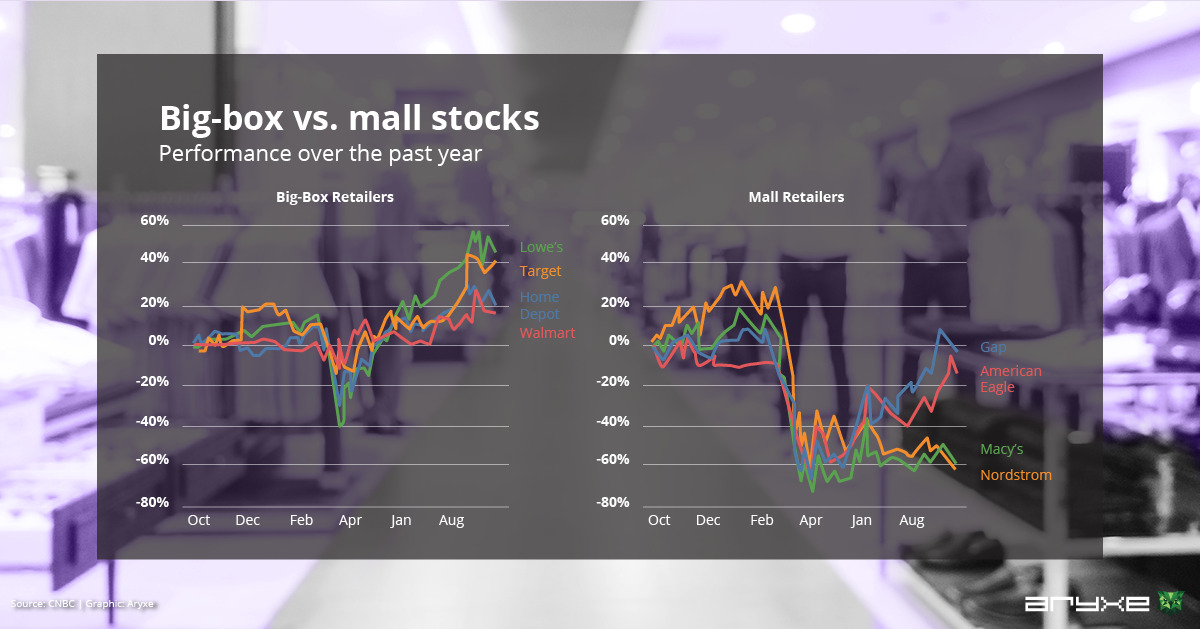
There is something retailers that have thrived during the pandemic have in common – They are all big-box retailers. They are seeing a rise in sales because of consumers who are deciding to skip the mall and shop at the big-box stores, or online instead.
Owners of big-box shops seem to agree on the reason for their success, and it all comes down to a diverse mix of merchandise.
According to McKinsey & Co. sales in specific categories mirror that contrast. Apparel revenue is expected to take a hit, industry-wide, and drop by 20% to 30% percent in 2020, while mass retailers, similar to Target and Walmart, are hoping to see apparel revenue grow by 10% or 20% compared to last year.
In Europe, both Lidl and Aldi aim to open new stores and grow their business. Both say they can take this long view with no external shareholders, despite the pandemic.
Well, this is the million-dollar question bothering retailers and retail real-estate developers.
In the United States, the biggest mall owner, Simon Property Group, is said to be in talks with Amazon about converting some Sears and J.C. Penney department stores into Amazon’s fulfillment centers. This is why many industry analysts have been adamant about seeing the future of malls as logistics hubs.
Simply because some retail spaces have gone vacant, it doesn’t mean it’s immediately a suitable candidate for recycling into industrial space. Moreover, it’s difficult to just start building industrial spaces in areas meant for commercial use. This venture often goes along with rezoning areas, which is a difficult and long process with rather low chances for success. In fact, industrial use comes with lower tax rates than spaces meant for commercial use. This simply means repurposing will make communities collect fewer tax revenues, which also makes little sense.
According to Moody Analytics data, an apartment development in the United States is forecast to be reduced by 15.6% in the after-Covid-19 world. Office development is set to drop 10%, while retail’s drop is around 15.7%. Meanwhile, industrial development is expected to pick up 3.6%.
Let’s do a little close-up now and see how some of the brands are doing. We won’t take sides or skip names, we’ll look at mass production brands but also haute couture.
The word around town is Inditex seeks to boost online retailing as coronavirus causes a 44% sales slump. Now, chances are you don’t know what Inditex stands for so let’s mention some of the brands under this coat name: Zara, Pull&Bear, Massimo Dutti, Bershka, Stradivarius, Oysho, Zara Home, and Uterqüe. Sounds familiar now? I’m sure you know at least one of these if not all. So the owner of Zara is expecting to close over 1,200 stores world-wide and focus on boosting online sales during this chaos brought by the Covid-19 pandemic.
Inditex made sure to reassure us saying that the closures won’t have a significant impact on the staff, as they are being offered roles in online channels. One of the world’s largest clothing retailers has suffered huge losses with sales down 44% to around 3.3 billion euros just between February 1st and April 30th. During the first quarter, they reported a net loss of 409 million euros as almost one-quarter of their shops remained closed by June 8th.
But that’s not all, and you may have already guessed it, online sales growth made up for a portion of the sales weakness. It actually rose by 50% YoY during the 1st quarter and was up to an astonishing 95% YoY in April.
The fashion brands Quiz and Monsoon Accessorize have also announced their plans to close branches and start the process of renegotiating rents, which will inevitably put thousands of jobs at risk and underline the impact of lockdowns on business in the retail sector.
Both Monsoon and Accessorize brands have been bought out of the administration by Peter Simon, their founder. He injected 15 million pounds into the business trying to save the brands, including around 2,300 jobs.
Let’s see how fashion in the haute couture world is holding on.
With the pandemic, Fédération de la Haute Couture et de la Mode went digital with the 20/21 collection. They went above and beyond with various digital presentations, such as teasers, short films, and sketches in order to adapt to the new world of fashion morphing into a digital format.
Disruption may even be too gentle of a word for what’s been going on in the world in 2020. This inevitably hit the fashion industry and the way it operates, thus forcing everyone to rethink their ways of designing collections and converting runways and fashion spectacles into a digital experience.
During the Haute Couture Fashion Week, every couture house had to express its own take on the digital format – which kind of makes us wonder what the future of fashion may end up looking like. Let’s go over some of the major brands’ ways of doing this:
Let’s take Dior as our first example. For the Autumn-Winter 2020-2021 Haute Couture collection, the house created 37 miniature couture silhouettes, embodying the actual quintessence of Dior’s eminent excellence. Some of these looks have also been created in life-size versions.
They used these looks to dive into the digital, presenting an exclusive 15-minute-long surrealist feature film titled ‘Le Mythe Dior’.
Viktor & Rolf on the other hand had a different take on the Autumn-Winter 2020 collection. Their pieces portray emotions that people experienced and were expressing online due to Covid-19. The famous duo made the collection come to life with details that were inspired by emojis, sparkly spikes, and hearts, while sending out a message of hope and how people need to be treating one another with more love and kindness during these unprecedented times.
Balmain did its thing by taking over the Seine as the runway for its Haute Couture A-W 2020 showcase. Their 2-hour spectacle was set to Livestream on TikTok, which was twofold, so while TikTok had their first luxury brand collaboration, Balmain was able to acquire over 15k new followers on the platform.
The coronavirus pandemic continues to disrupt retailers and keeps signaling an unprecedented disturbance of commerce. Retailers rarely do well in this type of disruption and some are facing a daunting multitude of both short and long-term challenges around the health and safety of their customers and staff, supply chain, labor force, cash flow, demand, and advertising.
The COVID-19 pandemic continues to force retail stores to close, signaling an unprecedented disruption of commerce. Incumbents rarely do well in this type of disruption. None of the ice-harvesting barons invested in ice factories and all the ice factories failed to foresee the advent of at-home ice makers. So, in order to live in a future where businesses will not only survive but also thrive, being able to anticipate what a post-coronavirus world looks like is going to be critical.
One of many fears is that this pandemic marked consumer behavior may end up becoming permanent. That means that aside from the transition to online shopping, people will be wary and germ-cautious – retailers will need to adapt and develop a no-touch consumer experience with a strong emphasis on hygiene and safety.
Some shopping malls are relying on Millennials. They say millennials are savvy, price-conscious shoppers that tend to prefer an in-shop experience although they do all their browsing online. One of the most valued experiences for Millennials seems to be dining out, which has actually contributed to a proliferation of restaurant concepts as part of malls. So, according to JLL, they are not only a generation of techies but foodies too.
Another type of their growing influence has led realty groups to look at their properties through a different lens. Initially, building shopping malls and centers were mostly focused on remote, cornfield areas. But now, they are shifting towards the densely developed suburban areas, instead. They aren’t located downtown, per se, but they are in markets where there’s an essentially equivalent population.
Unsurprisingly, there are people who actually believe that this is not the end of shopping malls. A survey conducted in Canada between May 25th and July 1st, 2020, reported that green spaces, trees, parklands, and relaxing environments would actually incite people to return to shopping malls when restrictions are lifted. People have already spent a lot of time at their homes, they will feel urged to get out there. Here’s what the survey found:
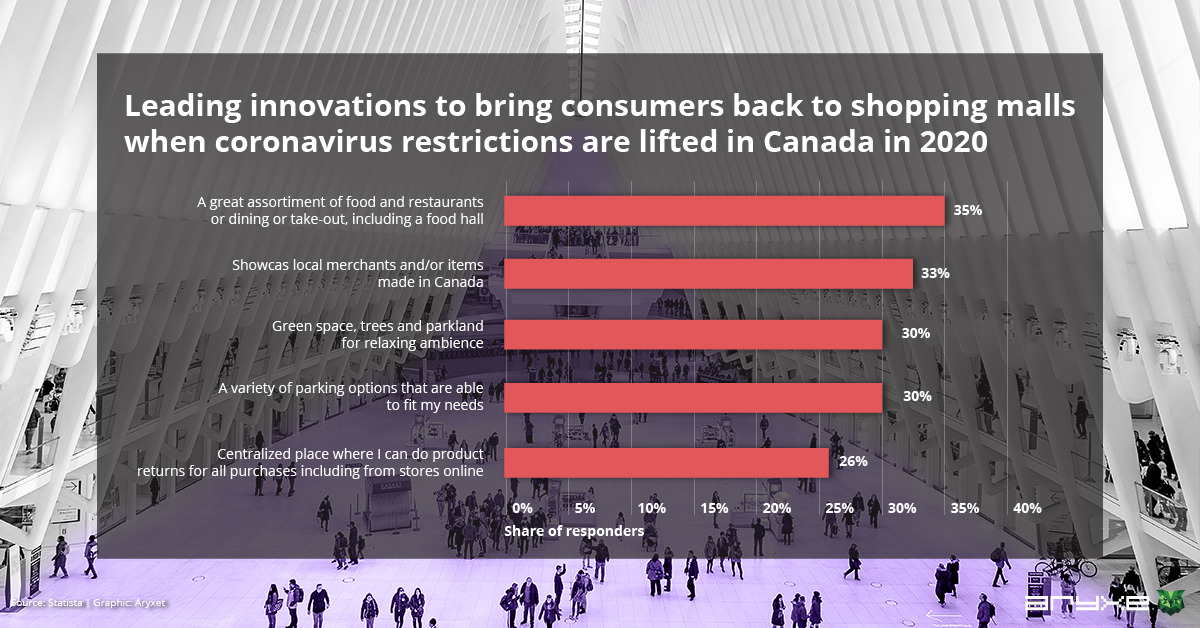
Maybe Covid-19 left you stranded, but we won’t. As in all our Covid-19 article series, we will give you tips on how to behave in order to keep the business going.
This may sound obsolete to you because you always need to know your customers, not just during a global pandemic. What you should also be aware of is that people are still shopping, it’s just that their shopping needs have changed. Your consumers are still out there, doing their thing but you now need to learn the difference between the “must-haves” and the “nice-to-haves”.
In order to not only survive Covid-19 but to actually be successful during and after the pandemic, a successful brand should be able to foresee and then also meet the needs of its customers. Research has shown that there has been an increase in demand for leisurewear and self-care products. So if you give that some thought, you can already see that when Covid-19 stops, there could be a significant spike in fancy clothing and makeup because people will be eager to go out. The key to your brands’ success is to know what your consumers need before they do. That means that you should also take care of your marketing accordingly.
The great news for all brands is that there hasn’t been a time when it’s been easier to engage with the consumers than now. Your potential customers are sheltering at home and bluntly, most of them are glued to their phones, their window to the outside world. People are craving connections, interaction, and familiarity. So, step up your social media game and make sure your brand stays relevant and on consumer’s minds even when the brick-and-mortar places are closed.
People want to know how serious you are when it comes to fighting the spread of Covid-19. That’s your chance to be transparent and also show them how much you actually care. It’s not all about the spending and buying, it’s about promoting positive and uplifting content that’s relevant to your consumers, which will, in turn, ensure they come back to you.
Chances are the post-covid world will carry some long-term changes alongside. If you consider this carefully, you may find many new opportunities for your brand to pivot and stay in-demand. Needing to go above and beyond traditional methods will be a must, including thinking about ways and options you have in order to engage consumers, while at the same time keeping them safe and healthy.
No one can have a certain idea of what a post-pandemic future will be like. And, although there are hopes that everything will just get back to “normal”, it’s clear that physical distancing, online shopping, and wariness may be our new normal for some time to come.
These new circumstances have caused unseen disruption and, in numerous cases, calamitous ramifications for many businesses across the world. Let’s face it, the many needs and desires of consumers that brands were catering to by building their businesses around have ended, almost overnight. Still, there’s hope and we are sure that retailers and brands will be inventive and do everything they can in order to stay ahead of the game.
Shopping malls around the world looked eerie, dead, and empty during the lockdowns introduced by governments worldwide. For decades now, malls have been both economic and social hubs. For many, malls have been a way of life.
Some would say that malls, vital spaces where people go to relax, exchange ideas, spend some downtime together, and simply hang out with one another, can’t be erased. On the other hand, there are those predicting entirely closed malls, that would follow Amazon’s footsteps and build fulfillment centers.
We feel like the concept of shopping malls won’t end up being dead at all. Having to buy different stuff and finding it in one place has been a definition of our world until today. Yes, you can definitely switch to doing all of that online but shopping online isn’t always the best experience, as I’m sure we all know. Still, imagining that shopping can transition into the online world, there are activities that people are used to doing in a mall, hanging out with their friends and sipping on a latte in between stores, taking the time to enjoy some delicious food or going there solely to watch a movie or a show. Bottom line is, shopping malls can’t be thought of as places where you only shop, there’s a little more to it, which actually may end up saving them after all.
Any reuse, transmission, republication, duplication or distribution of this article and graphics, without the express written permission of Aryxe is not allowed. If you wish to reuse, transmit, republish, duplicate or distribute this article, cite passages or use in full, including but not limited to proprietary text and graphics, please request a written permission.
https://www.bigcommerce.com/blog/retail/#the-history-and-evolution-of-retail-stores
https://www.merriam-webster.com/dictionary/agora
https://www.yourarticlelibrary.com/mall-management/history-of-malls-management/87292
https://www.bizlife.rs/what-is-the-future-of-shopping-malls/
https://www.voguebusiness.com/fashion/dolce-and-gabbana-couture-thriving-covid-19
https://www.mytotalretail.com/article/the-impact-of-covid-19-on-retailers-brands-and-marketers/
https://home.kpmg/xx/en/home/insights/2020/03/realities-of-retailing-in-covid-19-world.html
https://footwearnews.com/2020/business/retail/shopping-malls-store-traffic-coronavirus-1203044534/
https://www.statista.com/statistics/1154512/shopping-maps-post-pandemic-canada/
https://www.businessinsider.com/the-rise-and-fall-of-the-american-mall-2020-7
You are currently viewing a placeholder content from Default. To access the actual content, click the button below. Please note that doing so will share data with third-party providers.
More InformationInput your email to get the latest news in your inbox. We promise not to spam.